
Musical life of Szentes

Edited and translated by Aranyi László
Szentesi Folk-songs
People show their lives through their music. Their happiness and sorrow. They sing, play in musical instruments and dance.
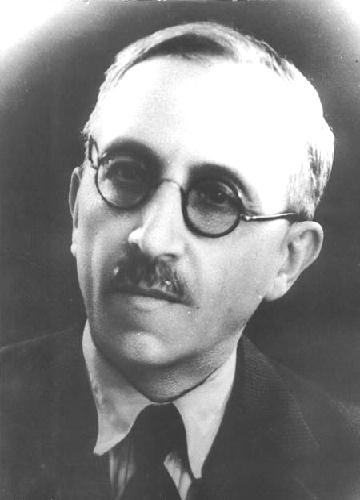 When
and what? There are many unwritten rules. Nearby our town you can find lots
of "treasures", without knowing of them it is not possible to understand
our ancestors' culture and we will not be able to continue our way to the future.
When
and what? There are many unwritten rules. Nearby our town you can find lots
of "treasures", without knowing of them it is not possible to understand
our ancestors' culture and we will not be able to continue our way to the future.
The repertoire of Szentesi folk songs are very rich, though there are some lyrics and some tunes wich are well-known in the other parts of Hungary as well. Lots of lyrics can be found in the local Koszta József Museum. Kodály Zoltán and Bartók Béla were also interested in our town's folk music. In 1906 and 1908 Bartók did some collecting activities here.
We can get lots of information about Szentesi folk music from Derzsi Kovács Jen§'s inheritance on folk music. He collected 250 folk songs. It is worth to know who was Derzsi Kovács Jeno. He wasborn on 16th May, 1889 and was the Horváth Mihály Comprehensive School's magnificent teacher. His father, Derzsi Kovács Ferenc, also was a teacher of the Horváth Mihály Comprehensive School. His grandfather, Zolnay Károly, was the founder member of the School and was its director for forty years. The family came to the town from Transylvania. Derzsi Kovács Jeno graduated in Szentes and later he got his diploma as a Chemistry and Biology teacher in Kolozsvár in 1912 and did his studies in a conservatory as well. All the members of the family were fond of music and were musical and could play any kinds of musical instruments. In 1913 he came back to Szentes and he continued his father's work. He taught, organized and lead scientific circles for students and in 1928 he founded a wind band. In that time ha lead a few chorus and bands as well. In 1934 he won a prize with his three compositions in the Hungarian Song-patronizing Committee's competition. He published these songs in the New Hungarian Song Repertoire Collection. His folk-song like compositions he won some national and international competitions.
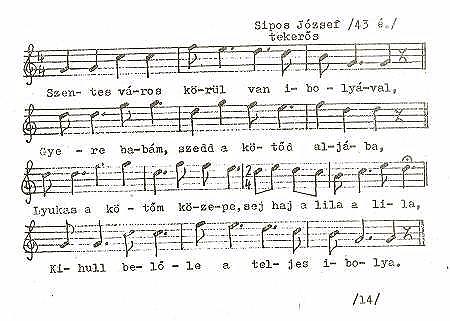
His musical knowledge was sophisticated therefore his recors are accurate. He could make differences between folk songs and Hungarian song in folk style. He often visited home to Transylvania where he made records on ethnography. He was interested in everything connected to Hungarian people and their culture: scenery, lifestyle, home, dress, etc. In the beginning these records were unorganized and incomplete. Years later he did his work with more accuracy and passionate. It is possible that Bartók's and Kodály's folk-song collecting work effected on his work. We can read some articles and notes.
From that point of time he started to research the melody treasure of Szentes and its surroundings in a much more accuracy and deliberately way. It is supposed that he started his collecting activities systematically in 1930. At Christmas, in 1939, he published an article in the Szentesi Diary, a local newspaper, and he wrote about the results of his work, the origins of the folk songs to be found, and their characteristics.
During his life he collected 250 folk songs and recorded them. Many of his recorded sheet musics notes and comments can be read.
Besides his versatile activities from 1939 he was the music study supervisor in the Szegedi school district. Until 1958, his retirement, he taught in the comprehensive school. In 1956 he got the Eminent Public Educator title, for the first time in Csongrád County. His written works on folk music are still topical and useful. He died on 12th April 1969 in Szentes.
His folk songs inheritance was arranged by Mrs. Forrás Katalin in 1985.
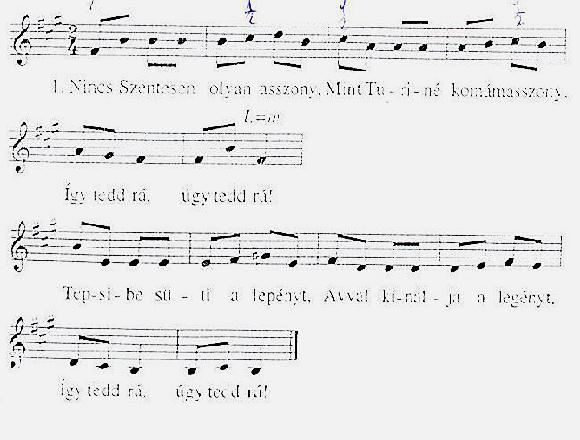
Most of the Szentesi folk songs show some effects of the church music of the medieval ages. We can hardly find pentatonic music scales among them, but their music system are different from the presently European music. Among the tunes there are very few which are similar to the well-known major and minor scales. In the other hand we can find some key systems from the age of ancient Greek music methods which were used in church music in the medieval ages. These keys named church music keys up to now. There are some folk songs in the collection whose keys are totally different from all of the keys we have known.
His memorial are being kept by the town. Respect for him there have been organized Derzsi Kovács Jeno National Folk Song Singing Competition since 1993 by Horváth Mihály Comprehensive School.
Instrumental folk music
In the end of the 1880s and the beginning of the 1900s wind-lutes, clarinets (reed-whistles), bagpipes, trombones, piccolos and zithers (tamburas) were used commonly in folk music.
Wind-lute
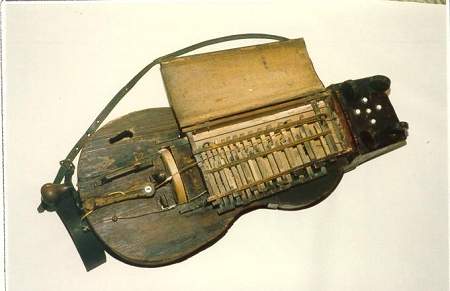
This musical instrument got to Hungary by the effects of the fashion wave of the French aristocracy sometime in the 19th century. After falling the Great French Revolution wandering musicians appeared all the parts of Europe. They came to Hungary as well, but in the beginning they had no any success. Just the very poor and simple people from the villages accepted the new musical instrument. Some talented and skillful villagers tried to make this interesting musical instrument, and soon everybody could hear our tunes and melodies. It was used manly in Szentes and Csongrád and their surroundings.
Wind-lute was very popular in Szentes. When Bartók Béla in 1906 and in 1908 visited Szentes he recorded some songs performed by wind-lute. Some years later musicians and singers from Szentes were invited to Budapest to make gramophone records. The best wind-lute player and wind-lute maker was the Szenyéri family.
Clarinet (reed whistle)

It was a very popular musical instrument in Germany in the 17th century. In Hungary, mainly in the peasant circles, it became common in the 19th century. Pastors liked it most of all. They played simple dance music in the reed whistles and in the leather bagpipes. The whistle of the clarinet could be made from feather and elder tree as well as reed, too. its tuning could be different. In folk music it was common to use A, H-flat and E-flat tuned musical instruments. We can hear together with wind-lute in other to make its primary's string's voice stronger.
Bagpipe
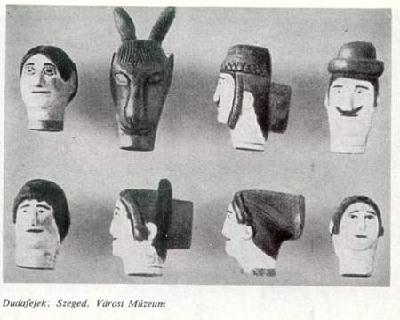
It got to Hungary in the 13th century from Asia Minor and was the best popular in Matthias Rex' Royal Curt. Later, mostly pastors, shepherds and swineherds played music with it. Also was often used and was very popular in wedding celebrations, carnivals and other kinds of balls. In the beginning of the 20th century it was just in use in the region of Szentes and Szeged.
In the museums of the mentioned towns there could be found ram-headed, and goat-headed bagpipes, but also very common the girl-headed and the man-headed (with moustache) bagpipes. The leather bottle made from different leather, mainly goat and sheep leather. The player blew the air into the leather bottle by using a blow-pipe or little bellows connected to the leather bottle and grasped the leather bottle to his body to press the air into the whistles. In this way the bagpipe gave sounds.
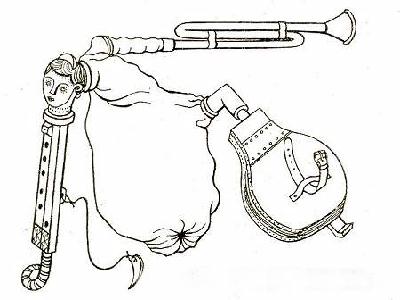
Some famous bagpipe-player of Szentes: Borza János, Borbély Imra and Kis Sándor.
Zither (tambura)
The ancestor of our most popular plucking musical instrument was well-known in the Persian-Turkic cultural area from the 1st centuries already. It was in the prime of its life in the 16th and 17th century in Europe. In Hungary there are records about its using from the end of the 19th century.
In Hungary zithers are put it groups on based on their shapes. They are: log zither, little headed zither and fat zither.
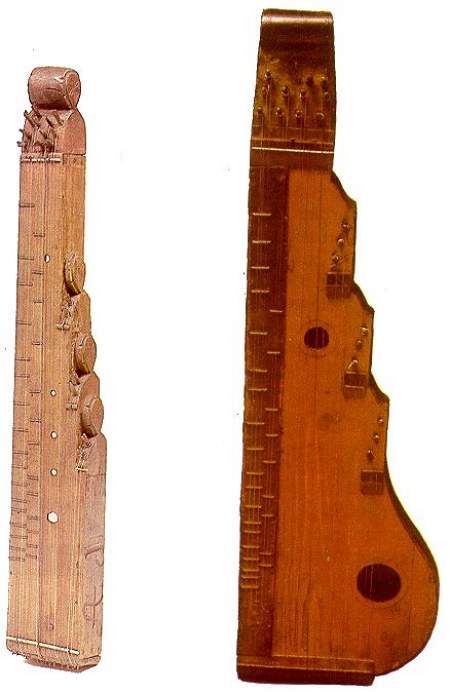
The simplest of them is the log like trough zither. In this type the body of the instrument was made form just one piece only. Its bottom was mostly opened. The melody playing strings were on the same musical scales.
Its bounds were made copper wire and were named kóta. In the beginning the zither was not able to play sharped and flatted sounds, it had one line of bounds and one kóta (full-kóta). Zither that is able to play sharped and flatted sounds has the name: half-kóta. In this case there were two line of bounds, so the name double-kóta was used in common as a folk idiom. Above the full-kóta there were three or four strings stretched and above the half-kóta there were just two. The concomitant or "guest" strings were tuned in different ways. it was common that all strings were tuned to the primary base sound. Strings, sound together with the melody, were tuned in triad. The lowest ringing strings was the roaring one. The part of the concomitant strings were mostly giving the rhythm, not to follow the melody. The player used a plucker made of goose-feather to "beat" the strings. With his left hand he grasped the pusher and pressed onto the bounds the melody strings. In the Great Plain most of the musicians did not use pushers, they played with their fingers.
The musical instruments were made by skillful agricultural workers. The bodies were curved from maple-wood, beech-wood or any other kinds of hard-wood. The bounds were place by not the measure but after hearing.
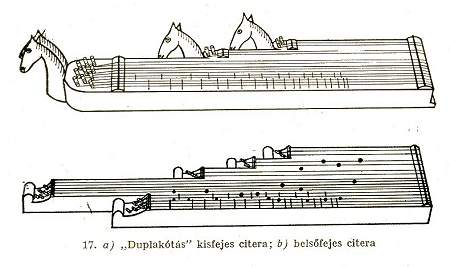
The most famous zither player of Szentes: Gránicz Terézia, Németh Kornélia and Törocsik László.
Other musical instruments
Some other types of musical instruments were used in common in folk music. They are: jug-pipe, spoon-zither, leaf-whistle, broom-violin, flute, trumpet, violin and so on.
Folk Dance
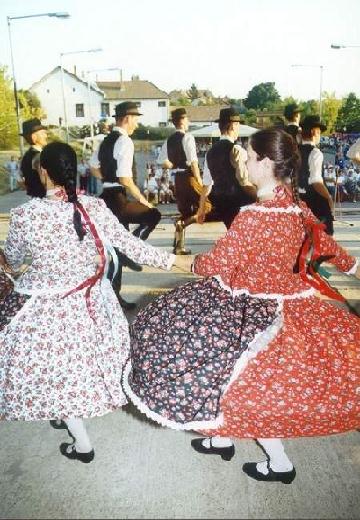
Besides of melodies and instrumental music moving and dancing were close the peasant culture. The previous technology did not give the possibility to take records on moving, so we have to use oral traditions, drawings, pictures and photos.
What occasions did people dance and play music? There were many opportunities in the peasant culture: name-days, wedding ceremonies, baptisms, pig-killing parties, stripping-parties (maize-strip), balls, house parties and chimney corner seat dusty parties. These dusty parties were very interesting, because the they were held in dirt ground rooms and during the dance dust was raised up from the ground and from the chimney corner seat. To avoid this the floor was watered with warm water and chaff was spread to the wet ground. The chaff was trample into the ground, then in the end of the parti, the chaff was swept out and the ground was wiped up with wet floor cloth and sprinkled up with sand. In this way, after the dance, the ground became smooth like glass.
Folk music is getting more and more popular recently, because of this in Lajtha László Music School folk music branch of learning was introduced in the Autumn 1997.
Forming of Choral Societies
Every moments of the Szentesi people's life inspired with music: they are singing when they are happy or sad. Thanks to the Reformed Church supporting activities the town get lots of help in his cultural and musical life. The bigger part of the inhabitants were Calvinist in the end of the 18th century, as a result from this the first school and the first Choral society were formed by the help of the Reformed Church. One of the most important purpose of the Reformed Church was to educate the youth. Skilled teachers give lessons it the schools, teach church music. The teachers had a very important part in spreading the singing of the sacred folk-songs and psalms. Church choirs were formed on this base. In the end of the century the Orthodox Church connected to this music and cultural aid work.
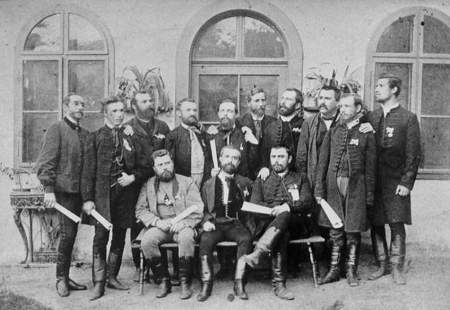
Folk music is totally different from the civil drawing rooms' music. The peasants' music's sounding world was different from the civil life's world. We can read about the "sophisticated" stratums' musical customs from 1861. For that time we cannot describe categories for classical music or light music as we do it presently, because in those days they were mixing in the most natural way. In the life of the local saloons there were very important part of the local lyricists. For example Joó Károly wrote melody to Nice Ilonka, a verse by Vörösmarty Mihály. In the social evenings it was common to perform the new compositions which were very similar to the folk music in their tones.
After the Compromise of 1867 the first choral society was formed in Szentes. It was lead and organized by Joó Károly who came from Szatmárnémeti and was a Calvinist choir-master. It consisted of men, because at that time the male choir tune was common. (Mixed choirs started to spread just from the beginning of the 20th century.) They gave their very important first performance in 1865 in the 25th anniversary of the Pest-Budai Musical Society (now it is Liszt Ferenc Music Academy).
Liszt Ferenc was conducted the Szentesi group in this concert. The wonderful Alleluia from Messiahs by Handel, Rákóczi-Marsh and the oratorio on Saint Elizabeth of Hungary by Liszt Ferenc were on their repertoire. In this concert there could be heard our National Anthem for the first time in public, because it had been inhabited after the falling of our Revolution of 1848-1849. The Szentesi choring society gave their next concert in Arad, in 1867.
This concert was really a protestant against the Compromise of 1867. The groups had 13 member of that time and they won the first prize from the 44 choral societies. Though they got the Silver Laurel Wreath.
After this success they gave many wonderful concerts. In 1876 they were in Szeged in a Festival accompanied by a band.
It was awaited by the cultural age that the musicians had to give folk-song like compositions. Szentesi citizens enjoyed themselves for that type of music in the balls and dance-evenings. Csardases, composed by Joó Károly, were very popular at that time.
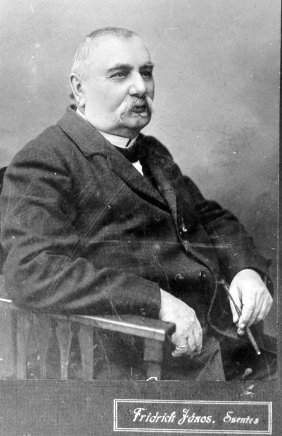
Joó Károly
From 1879 the Choral Society declined. It was because the members of the group got old and the cholera epidemic. In 1880 the successful group stopped. After a short brake Joó Károly, who was teaching in the local Calvinist Comprehensive School at that time, formed a choir in the school. But he missed the choral society very much, so, by the press of the public, he formed a small a new one. They also became very successful. But in a decade they stopped, too. Joó Károly got the Gold Merit Cross from the king of Hungary in 1911 for his 50 years work. He died in 1917.
At this time new type of music appeared in the musical life, gipsy bands became more and more popular. From the leaders of the gipsy bands Farkas Zsiga was the best folk-music composer.
Szentes could not exist for longer time without a choral society. The life of the average people did not change a lot since the Compromise of 1867. Peasants ploughed, went to markets, to pubs, to clubs and to churches. the civil stratum also liked to have fun, they visited to cafeterias, balls és other dance evenings. Németh Elek, the Calvinist teacher, took the "relay baton" from Joó Károly in 1894. He formed the second choral society of the town from the self-educated circle of the youth craftsmen. At that time not this group was the only one in the town, but some other little groups as well who tried to work in the town's cultural life. For the second choral society the lack of money was the most serious problem.
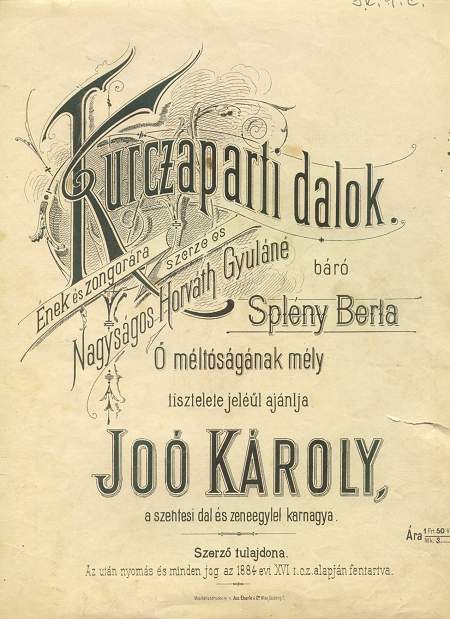
In 1897 there was formed the town's first mixed choir. This new kind of sound world aroused the public's interest. Besides of salons and concert rooms they could be heard in churches, in places of amusement and in balls as well.
In October 1904 the third choral society was formed. Its name was Singing Circle. They became very famous in the next ten years. The next choral society, the Craftsmen Singing Circle was formed after the World War I It was followed by many others. One of the most importance was the 100 Membered Choral Society, which was connected to the Culture Society of Csongrád County and worked until 1920. From that point of time, because of the general economic depression and the World War II, the functioning of the bands and choirs, unfortunately, were pushed back.
Our famous song composer - Csajághy Gyula
He was born in 1875 in Csongrád. His started with lots of adventures. It was known that he was a foundling child and was grown up by the Szentesi Csajághy family. His original name was Szóke Gyula - by this version. By the other version, he was an orphan of some of the family's relatives, and he was adopted by the child lovers relatives. The family's historical origin is proved though. We can meet the name, Csajághy János, as a brigadier-general of Rákóczi Ferenc II. The same person was on of the signers of the peace agreement of Szatmár. Later the women became well-known from the family. Csajághy Laure was the wife one of our best poet, Vörösmarty Miháll and Csajághy Julianna was the wife of Bajza József.
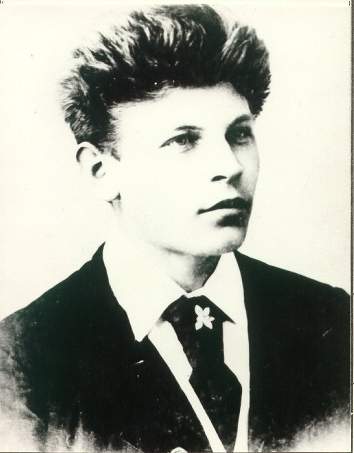
Csajághy Gyula was young already when it turned out that he was talented in writing poems, playing music and act. His published first when he was only 16 in the Tiszavidék magazin. His father protested against Gyula's "hobbies" but all of his efforts were vain. By his parents' wish he learned the traditional family skills: to bleed somebody, to take a tooth out, to cut somebody's hair, and so on. In spite of this he did not finish with writing poems and composing songs. He was wandering about in the country, he was attracted by the unknown. He met Pósa Lajos, Szabolcska Mihály and Dankó Pista in Szeged. Next step in his life was Budapest, where the New Budapest, the Közérdek and the Borsszem Jankó published his poems. He tried to write dramas as well and because of this he got his pen-name that was Darázs Miska. At this time he composed his most popular songs: The Egri girls..., Corps are riping... They can be heard recently as well, and they are know in the whole country.
He was got to Csépa by his destiny where he opened a barber's shop. He formed the Craftsmen Choral Society and consisted of the history of Csépa. After his wife's and child's death he got married again, but his destiny landed him in a difficulty again: his one-year-old daughter disappeared from his yard and was found two years later in Szigetszentmiklós. His life continued in Újszentes. During the World War II he was a sanitarian, later he was taken prisoner of war by the russians. He got to a musical instrument factory there, where he learned out the tricks of making violin. Soon he escaped and work in Ferencváros, in the Small Forest workers' colony as a warden. At the time he heard his own song in the film, titled Hungarian Rhapsody, the Corps are riping... with a little changing in its test. Several years' litigation was started and he was the one who lost. He was exhausted and got to Szentes on foot. He often published his work in his pen-name Darázs Miska or Vén Darázs (old wasp). Choosing the pen-name was not a chance, because he had got a wasp covered with iron that he wore on his tie with a great pleasure.
His songs and text reflects the life of the people of the Great Plain. We can recognize some effects of Pósa Lajos and Gárdonyi Géza. Some of his sketches remained to us and they are consisted the major and the minor versions of the songs. His music scales was particular. He liked to change octave tune and the big sound intervals. The range of voice of his songs are big, so he had the opportunity to the developing of his melodies. In this way his songs were easy to learn and sing. There are some similarity to the modern style folk songs since there are some fifth changes in the structures of his songs. One of Csajághy's speciality is the third change, that is not familiar in the Hungarian folks songs. Sequences are often can be heard in his songs. His rhythms are typical Hungarian: using sharp and stretched rhythms are typical. His tempo signs are often incorrect. This means he had some lack of musical knowledge. The music sheets for the accompaniments on the piano were often written by helpful friends. The author, because he did not know how to write music sheets, used his instinct, that is his song-writing's virtue.
His life-work was acknowledged by his contemporaries too. His greatest signification was the first prices of the "Intercontinental" Folk-Song Like Compositions for Middle-European Composers in 1893 and on the same competition in 1935.
History of the Szentesi Music Teaching
In the first some decades of the 2th century the doors of the noble people's salons were opened for the richer citizens of the town. In these afternoons and evenings classical music could be heard as well. The salon music was not played in the most popular musical instruments, but, according to the fashion, in the piano and in the violin. Better-to-do people took every opportunities to have their children taught music.
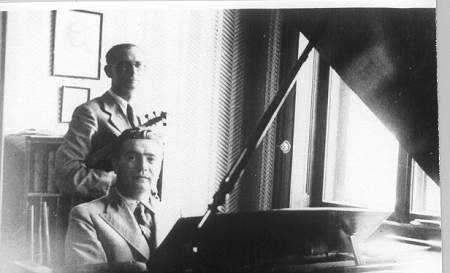
Jákó Dezs§ és Briher István
Jákó Dezso was born in Szentes, in 1884. He started to go to school in Szentes as well. He got his diploma as a school-teacher in Sárospatak in the State Teacher Training Institution. Later he studied music as a student of Kodály Zoltán in the music composer faculty in the Musical Art Collage. As a result of his permanently learning and his continuously self-educating he got his singing teacher diploma in 1924 and his music teacher diploma in 1947. During that time he was employed as a teacher, as an organ player, as a cantor and as a teacher of religion, but he was engaged of teaching composing and choral singing as well. He opened a private music school in Budapest in 1929 then he tried to find a job in his native town.
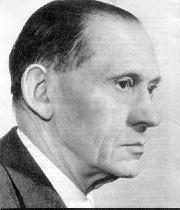
Lajtha László
He was the first important person in our town's music teaching history. In 1933 he founded the first private music school in Szentes and not soon it became very popular. By 1937 there were some students who after finishing their studies in Szentes passed their entrance examinations to the Musical Art Collage with success.
During his activity the town reached its highest point of its life on chamber music. Successful social afternoons and evenings on chamber music were held regularly in the Péter-House. In 1938 he gave lessons in the Higher Elementary School for Girls. Closely connected to his activities he gave a boost to the cultural life of the town. During his staying at Szentes (1933-1939) he was the leader of the Szentesi Cultural Association's philharmonic orchestra, conducted the Craftsmen Choral Society. Of course he did not leave his composing knowledge unutilized. In the 23rd National Competition on Composing Music he won the first prize for setting music to a poem of Petofi Sándor, titled: The thirsty man's wondering.
His life-work consisted of compositions for piano, pieces of orchestral music and marshes.
He was the era's popular composer, conductor and performer. His music was played in concert rooms and in the Hungarian Radio as well. He left the town in 1939 and moved to Debrecen, where he lead the Debreceni Bocskai Orchestra. Historical events arouse his interest to the military music, so in 1942 he passed a soldier conductor examination. During the World War II he was captured and after his releasing he got to Debrecen and was a teacher paid by the hour until his dead.
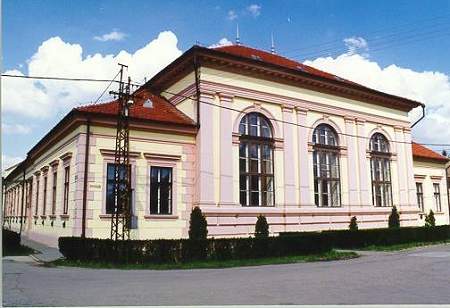
Lajtha László Music School
In Szentes Briber István (violin teacher) became the new director who could hardly overcome the difficulties. Though the school was very successful earlier. The number of the students were seriously decreased because of the war. These circumstances made the situation worse.
From 1949 the musical education was the task of the musical collective. Their first aim was the discontinuance and sifting out of the bungler teaching, directing the teachers who had no diplomas and helping them of their in-service training.
The starting of the institutional musical education can be date in the beginning of the 1950s. Teachers, formed a working group, not only taught Szentesi students but students from the nearby villages (Fábiánsebestyén, Nagymágocs, Szegvár, Derekegyház, MIndszent) as well. In that years two working groups of teachers were formed spontaneously by private initiative in the area if the town. One of them got place for giving lessons in the Horváth Mihály Comprehensive School. The leader of his group was Dr. Aranyi Gábor (my father) who was the director of the Management Departure of the local council at that time. The pianist teacher was the former Csongrádi general notary, Dr. Széke István, who was deprived of his job, because of his "class-alien thinking". Because of his professional knowledge on playing the piano he was a appreciated person in Szentes. A woman from Hódmezovásárhely was the violin teacher for a short time. Solfaggio and musical theory was taught by Galli János, Csongrádi general cantor.
The other work group was lead by Balogh Gyula, a primary school teacher. Mrs. Dégi was the violin and Mrs. Priviczer was the piano teacher. Two the groups was joined by the permission of the Ministry. After this they activities increased.
The purpose of the new leadership was to take the school into public ownership. Many of the students, who reached excellent result, took part that the Cultural Ministry found a Stately Musical School for the inhabitants of Szentes in 1955. The school got support to finance four teachers, a warden and 100 students. They had no a building, so Erdélyi Péter, director of the school for the handicapped, gave place for the lessons in the afternoons. Mrs Dégi got commission to lead the staff. During the next few years the school increased in the number of students and in objective and personal conditions.
In 1956 it got its own place in the building of the Noble Casino, where it can be found today as well. The prestige of the school and the appreciation by the public was increasing because of the growing up in numbers of the musical instruments, the teachers further training in collages, founding orchestra from the students and it success. Leading by Veréb Imre and Szappanos Eniko new branches of study were founded: wood-winds and gordon. It was a good advantage of Dr Blankeinstein János's appointment. But, because of his county origin, he could work as a teacher paid by hours.
One of the most remarkable events was the first concert for his native town's audience by Lehota András Jr. in 1968, which was held in the occasion of getting his diploma in the Musical Academy.
The institution took the name, Lajtha László, in 1989. In its concert room there could be seen number of artists, some former students between of them. The basic purpose of the school is to teach plaing in musical instruments, music methods and to prepare students for entrance examinations to collages and to educate a connoisseur and music-lover audience.
Life of choruses and orchestras
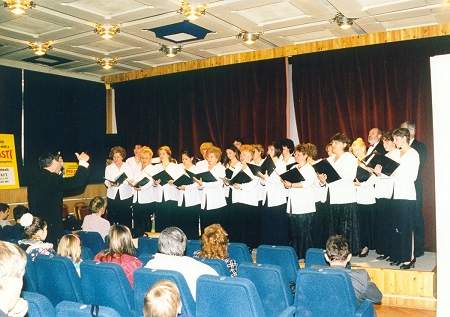
Bárdos Lajos Mixed Chorus
The term of the World War II was a drawback to increasing our musical life. From 1945 "workshop cultural groups" were formed one after the other. In that way dramatic societies, choruses and orchestras were founded.
It would be very difficult to list all of them, here are some: Young Craftsmen's Chorus, Officers' Club Chorus, Horváth Mihály Comprehensive School's chorus and so on. Until 1960s the St. Anna Church's Choir was very famous, lead by Mandula József assistant minister and by Ihász István pharmacist. In 1957, Petofi Sándor Promary Scool's Chorus was formed. Some year later they could reach national success.
The local mixed chorus was found by Hárs László szinging teacher and lead until the beginning of the 1950s. When he was transferred, by the request of the chorus' maintainer, by the request of the Teachers Trade Union, Galli János was asked to lead the chorus. He accepted the request and lead the chorus until 1960. Their work was helped by Erdos Péter, director of the school for handicapped. The members of the chorus mostly were kindergarten teachers, school-teachers, teachers, but there were some with different profession among them as well.
In their high standard repertoire there could be found the wide range of the era's choral works. The chorus gave performance not only in the local celebrations regularly, but in the county and national programmes as well. Some of the chorus members took part in the Teachers' Dramatic Players festival. They acted out an operetta the Three Gratias by Rerté-Schubert accompanied by the local orchestra.
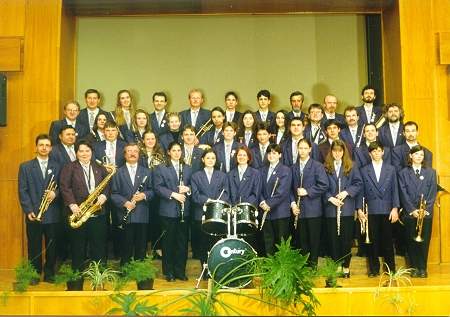
Local Wind Band
In 1977 the local mixed chorus was reorganized by the music lovers teachers and students of the Musical School. The chorus of forty is still working. They give concert in the whole country an in foreign countries, too. They lead by the conductor Nagy János who is the director of the Musical School as well. In 1982 the chorus got the Pro Szentes award. In 1986 they took their name Bárdos Lajos Mixed Chorus, with the permission of the family, after the composer's death. Their repertoire covers the great eras of the European Musical Culture from the renaissance up to now. The chorus's promotion is continuos. After the first silver grade the reached the highest grade by today. Their activities are signed by many many radio and television records. They got many county, national and international awards. In 1996 they got the Festival Chorus classification in the National Qualification Competition. The most important event in our Millenneum year for them was to get the Concert Chorus classification.
In 1997 Szentesi Music-Lovers Association was formed by the help of the local wind band. Our Musical school is famous nationwide.
Szentesi Cultural Assosiation
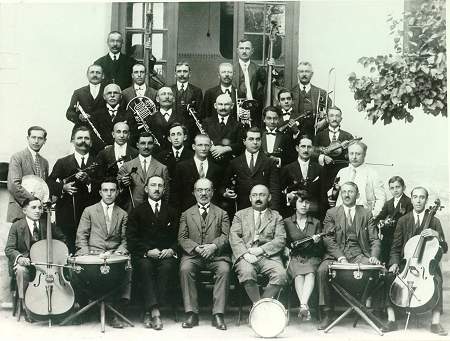
In 1926 some music-lover people founded the local symphony orchestra that reached a lot of great success to the town. Some of the most enthusiastic organizers are the next: Derzsi Kovács Ferenc, Derzsi Kovács Jeno, Briher István and Dr. Székely Alfréd. In the beginning they gave their concerts under the name of Szentesi Cultural Association' Philharmonic Orchestra, and later Symphony Orchestra. It consisted of 11 violinists, 2 viola players, 2 cellists, 2 double-bass players, 2 trumpeters, 2 clarinetists, 1 horn-player, 2 trombonists and 3 percussions. They gave their first concert on 1st September, 1927. After the successful first night they gave some concerts in every year. First Derzsi Kovács Jeno was the conductor of the orchestra and then Briher István.
The success of the orchestra was hallmarked by using guests conductors from the National Opera House. Plenty of artists came to our town. Besides the players they had a chamber chorus as well.
Szentesi Small Symphony Orchestra.
In the spring of 1951 Dr. Aranyi Gábor found the group from the musicians who were living in the town. Dr. Szoke István was the leader in the beginning, later Galli jános, until 1960.
The composition of the orchestra was mixed. Besides of the Music School's private teachers there were some amateur musicians as well. There were missing a number of wind players, and there were just one string for each tunes except for the violin. There was much need for inventiveness and ingenuity. Sometimes it occurred that one of the wood-brass player was missing and he was supplied by the popular doctor of the town, Dr. Péter Pál, who played the harmonium instead of any wood-brass instrument. Their repertoire consisted of Bach's, Beethoven's, Handel's, Weber's, Erkel's, Kodály's and Martók's compositionjs. They played light music as well.
Móricz Zsigmond Cultural House' Wind Band (Pioneer Band)
It was founded in 1950. It was conducted by Puruczkai Mihály who was a versatile, talented person and could play in many musical instruments. He educated more generations of music players. He got a status in the Musical School as an unqualified teacher that gave him a secure background. He had some problems because of his lack of qualification, but his natural talents on music gave him the chance to be a successful conductor.
The Greatest Szentesi Contemporary Composer - Balázs árpád

He was born in 1937. Erkel Prize winner, he was given the freeman of Szentes in 1988. His parents were teachers. His father was interested in music, he was a famous conductor besides of teaching. He graduated from the local Horváth Mihály Comprehensive School. His studying on music started in Hungary but he took lessons in abroad as well. He got his diploma in Liszt Ferenc Music Academy on composing faculty. Besides of his teachers we could find Farkas Ferenc and Aram Hacsaturján. After finishing the university he started to collect Szentesi folk-songs and navvy songs. He composed many compositions for children's choirs. These songs are very popular pieces of the schools' choirs' repertoires. Ho composes music for every age-groups. It is typical in his composition of using the elements of folk-songs. He was asked in many occasions to be a member of the jury, in Hungary and in abroad, too. He is the chairman of many associations and foundations. For his work he got plenty of awards and medals.